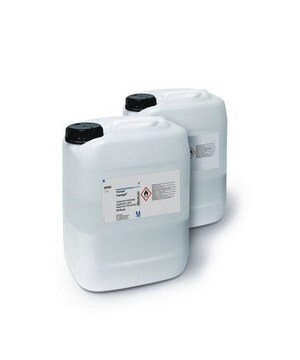1.02330
Cellulose microcrystalline
for thin-layer chromatography
Sinónimos:
Cellulose microcrystalline
About This Item
Productos recomendados
Materiales
cellulose matrix
plastic support
Nivel de calidad
Formulario
microcrystalline
temp. de autoignición
232 °C
potencia
>5000 mg/kg LD50, oral (Rat)
>2000 mg/kg LD50, skin (Rabbit)
Características
binder Organic Polymer
fluorescent indicator: no
envase
pkg of 500 g
técnicas
thin layer chromatography (TLC): suitable
tamaño de partícula
5-40 μm
tamaño de poro
60 Å medium pore diameter
pH
5-7.5 (20 °C, 100 g/L in H2O, slurry)
temperatura de transición
flash point 260 °C
densidad
1.5 g/cm3 at 20 °C
densidad aparente
70‑400 kg/m3
temp. de almacenamiento
2-30°C
cadena SMILES
O1[C@H](C(C(C(C1CO)O)O)O)O[C@@H]2C(OC(C(C2O)O)O)CO
InChI
1S/C12H22O11/c13-1-3-5(15)6(16)9(19)12(22-3)23-10-4(2-14)21-11(20)8(18)7(10)17/h3-20H,1-2H2/t3?,4?,5?,6?,7?,8?,9?,10-,11?,12+/m1/s1
Clave InChI
GUBGYTABKSRVRQ-WFVLMXAXSA-N
Descripción general
Aplicación
- Study of the influence of cellulose derivatives on physical and analytical attributes of a drug product belonging to BCS class II.: This research explored the impact of cellulose microcrystalline on the physical properties and analytical performance of a class II drug product. The findings demonstrated the role of cellulose microcrystalline in enhancing the stability and dissolution rate of the drug, contributing to improved bioavailability (Domoslawska et al., 2018).
- Application of ethyl cellulose, microcrystalline cellulose and octadecanol for wax based floating solid dispersion pellets.: The study investigated the use of microcrystalline cellulose in the formulation of wax-based floating pellets. The results highlighted its effectiveness in controlling the release profile and enhancing the floating properties of the drug delivery system (Yan et al., 2016).
- Modelling of porosity and waterfronts in cellulosic pellets for understanding drug release behavior.: This paper presented a model for analyzing the porosity and water penetration in cellulosic pellets, providing insights into the drug release mechanisms. The study emphasized the crucial role of microcrystalline cellulose in modulating drug release profiles (Gomez-Carracedo et al., 2010).
- Fast dissolving films made of maltodextrins.: The research explored the incorporation of microcrystalline cellulose in fast-dissolving films, demonstrating its impact on film integrity and dissolution rates. The findings support the use of microcrystalline cellulose in enhancing the performance of oral thin films (Cilurzo et al., 2008).
- Compressibility of floating pellets with verapamil hydrochloride coated with dispersion Kollicoat SR 30 D.: This study evaluated the compressibility and mechanical properties of floating pellets containing microcrystalline cellulose, showing its role in maintaining pellet integrity and controlled drug release (Sawicki & Lunio, 2005).
Nota de análisis
d 50 (laser diffraction, size distribution): 10 - 30 µm
d 90 (Laser diffraction, size distribution): 30 - 60 µm
Producto relacionado
Código de clase de almacenamiento
11 - Combustible Solids
Clase de riesgo para el agua (WGK)
WGK 1
Punto de inflamabilidad (°F)
Not applicable
Punto de inflamabilidad (°C)
Not applicable
Certificados de análisis (COA)
Busque Certificados de análisis (COA) introduciendo el número de lote del producto. Los números de lote se encuentran en la etiqueta del producto después de las palabras «Lot» o «Batch»
¿Ya tiene este producto?
Encuentre la documentación para los productos que ha comprado recientemente en la Biblioteca de documentos.
Los clientes también vieron
Nuestro equipo de científicos tiene experiencia en todas las áreas de investigación: Ciencias de la vida, Ciencia de los materiales, Síntesis química, Cromatografía, Analítica y muchas otras.
Póngase en contacto con el Servicio técnico


